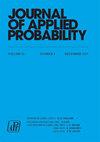求助PDF
{"title":"大型随机置换矩阵的极限谱分布","authors":"Jianghao Li, Huanchao Zhou, Zhidong Bai, Jiang Hu","doi":"10.1017/jpr.2024.8","DOIUrl":null,"url":null,"abstract":"We explore the limiting spectral distribution of large-dimensional random permutation matrices, assuming the underlying population distribution possesses a general dependence structure. Let <jats:inline-formula> <jats:alternatives> <jats:inline-graphic xmlns:xlink=\"http://www.w3.org/1999/xlink\" mime-subtype=\"png\" xlink:href=\"S0021900224000081_inline1.png\" /> <jats:tex-math> $\\textbf X = (\\textbf x_1,\\ldots,\\textbf x_n)$ </jats:tex-math> </jats:alternatives> </jats:inline-formula><jats:inline-formula> <jats:alternatives> <jats:inline-graphic xmlns:xlink=\"http://www.w3.org/1999/xlink\" mime-subtype=\"png\" xlink:href=\"S0021900224000081_inline2.png\" /> <jats:tex-math> $\\in \\mathbb{C} ^{m \\times n}$ </jats:tex-math> </jats:alternatives> </jats:inline-formula> be an <jats:inline-formula> <jats:alternatives> <jats:inline-graphic xmlns:xlink=\"http://www.w3.org/1999/xlink\" mime-subtype=\"png\" xlink:href=\"S0021900224000081_inline3.png\" /> <jats:tex-math> $m \\times n$ </jats:tex-math> </jats:alternatives> </jats:inline-formula> data matrix after self-normalization (<jats:italic>n</jats:italic> samples and <jats:italic>m</jats:italic> features), where <jats:inline-formula> <jats:alternatives> <jats:inline-graphic xmlns:xlink=\"http://www.w3.org/1999/xlink\" mime-subtype=\"png\" xlink:href=\"S0021900224000081_inline4.png\" /> <jats:tex-math> $\\textbf x_j = (x_{1j}^{*},\\ldots, x_{mj}^{*} )^{*}$ </jats:tex-math> </jats:alternatives> </jats:inline-formula>. Specifically, we generate a permutation matrix <jats:inline-formula> <jats:alternatives> <jats:inline-graphic xmlns:xlink=\"http://www.w3.org/1999/xlink\" mime-subtype=\"png\" xlink:href=\"S0021900224000081_inline5.png\" /> <jats:tex-math> $\\textbf X_\\pi$ </jats:tex-math> </jats:alternatives> </jats:inline-formula> by permuting the entries of <jats:inline-formula> <jats:alternatives> <jats:inline-graphic xmlns:xlink=\"http://www.w3.org/1999/xlink\" mime-subtype=\"png\" xlink:href=\"S0021900224000081_inline6.png\" /> <jats:tex-math> $\\textbf x_j$ </jats:tex-math> </jats:alternatives> </jats:inline-formula><jats:inline-formula> <jats:alternatives> <jats:inline-graphic xmlns:xlink=\"http://www.w3.org/1999/xlink\" mime-subtype=\"png\" xlink:href=\"S0021900224000081_inline7.png\" /> <jats:tex-math> $(j=1,\\ldots,n)$ </jats:tex-math> </jats:alternatives> </jats:inline-formula> and demonstrate that the empirical spectral distribution of <jats:inline-formula> <jats:alternatives> <jats:inline-graphic xmlns:xlink=\"http://www.w3.org/1999/xlink\" mime-subtype=\"png\" xlink:href=\"S0021900224000081_inline8.png\" /> <jats:tex-math> $\\textbf {B}_n = ({m}/{n})\\textbf{U} _{n} \\textbf{X} _\\pi \\textbf{X} _\\pi^{*} \\textbf{U} _{n}^{*}$ </jats:tex-math> </jats:alternatives> </jats:inline-formula> weakly converges to the generalized Marčenko–Pastur distribution with probability 1, where <jats:inline-formula> <jats:alternatives> <jats:inline-graphic xmlns:xlink=\"http://www.w3.org/1999/xlink\" mime-subtype=\"png\" xlink:href=\"S0021900224000081_inline9.png\" /> <jats:tex-math> $\\textbf{U} _n$ </jats:tex-math> </jats:alternatives> </jats:inline-formula> is a sequence of <jats:inline-formula> <jats:alternatives> <jats:inline-graphic xmlns:xlink=\"http://www.w3.org/1999/xlink\" mime-subtype=\"png\" xlink:href=\"S0021900224000081_inline10.png\" /> <jats:tex-math> $p \\times m$ </jats:tex-math> </jats:alternatives> </jats:inline-formula> non-random complex matrices. The conditions we require are <jats:inline-formula> <jats:alternatives> <jats:inline-graphic xmlns:xlink=\"http://www.w3.org/1999/xlink\" mime-subtype=\"png\" xlink:href=\"S0021900224000081_inline11.png\" /> <jats:tex-math> $p/n \\to c >0$ </jats:tex-math> </jats:alternatives> </jats:inline-formula> and <jats:inline-formula> <jats:alternatives> <jats:inline-graphic xmlns:xlink=\"http://www.w3.org/1999/xlink\" mime-subtype=\"png\" xlink:href=\"S0021900224000081_inline12.png\" /> <jats:tex-math> $m/n \\to \\gamma > 0$ </jats:tex-math> </jats:alternatives> </jats:inline-formula>.","PeriodicalId":50256,"journal":{"name":"Journal of Applied Probability","volume":"50 1","pages":""},"PeriodicalIF":0.7000,"publicationDate":"2024-04-12","publicationTypes":"Journal Article","fieldsOfStudy":null,"isOpenAccess":false,"openAccessPdf":"","citationCount":"0","resultStr":"{\"title\":\"The limiting spectral distribution of large random permutation matrices\",\"authors\":\"Jianghao Li, Huanchao Zhou, Zhidong Bai, Jiang Hu\",\"doi\":\"10.1017/jpr.2024.8\",\"DOIUrl\":null,\"url\":null,\"abstract\":\"We explore the limiting spectral distribution of large-dimensional random permutation matrices, assuming the underlying population distribution possesses a general dependence structure. Let <jats:inline-formula> <jats:alternatives> <jats:inline-graphic xmlns:xlink=\\\"http://www.w3.org/1999/xlink\\\" mime-subtype=\\\"png\\\" xlink:href=\\\"S0021900224000081_inline1.png\\\" /> <jats:tex-math> $\\\\textbf X = (\\\\textbf x_1,\\\\ldots,\\\\textbf x_n)$ </jats:tex-math> </jats:alternatives> </jats:inline-formula><jats:inline-formula> <jats:alternatives> <jats:inline-graphic xmlns:xlink=\\\"http://www.w3.org/1999/xlink\\\" mime-subtype=\\\"png\\\" xlink:href=\\\"S0021900224000081_inline2.png\\\" /> <jats:tex-math> $\\\\in \\\\mathbb{C} ^{m \\\\times n}$ </jats:tex-math> </jats:alternatives> </jats:inline-formula> be an <jats:inline-formula> <jats:alternatives> <jats:inline-graphic xmlns:xlink=\\\"http://www.w3.org/1999/xlink\\\" mime-subtype=\\\"png\\\" xlink:href=\\\"S0021900224000081_inline3.png\\\" /> <jats:tex-math> $m \\\\times n$ </jats:tex-math> </jats:alternatives> </jats:inline-formula> data matrix after self-normalization (<jats:italic>n</jats:italic> samples and <jats:italic>m</jats:italic> features), where <jats:inline-formula> <jats:alternatives> <jats:inline-graphic xmlns:xlink=\\\"http://www.w3.org/1999/xlink\\\" mime-subtype=\\\"png\\\" xlink:href=\\\"S0021900224000081_inline4.png\\\" /> <jats:tex-math> $\\\\textbf x_j = (x_{1j}^{*},\\\\ldots, x_{mj}^{*} )^{*}$ </jats:tex-math> </jats:alternatives> </jats:inline-formula>. Specifically, we generate a permutation matrix <jats:inline-formula> <jats:alternatives> <jats:inline-graphic xmlns:xlink=\\\"http://www.w3.org/1999/xlink\\\" mime-subtype=\\\"png\\\" xlink:href=\\\"S0021900224000081_inline5.png\\\" /> <jats:tex-math> $\\\\textbf X_\\\\pi$ </jats:tex-math> </jats:alternatives> </jats:inline-formula> by permuting the entries of <jats:inline-formula> <jats:alternatives> <jats:inline-graphic xmlns:xlink=\\\"http://www.w3.org/1999/xlink\\\" mime-subtype=\\\"png\\\" xlink:href=\\\"S0021900224000081_inline6.png\\\" /> <jats:tex-math> $\\\\textbf x_j$ </jats:tex-math> </jats:alternatives> </jats:inline-formula><jats:inline-formula> <jats:alternatives> <jats:inline-graphic xmlns:xlink=\\\"http://www.w3.org/1999/xlink\\\" mime-subtype=\\\"png\\\" xlink:href=\\\"S0021900224000081_inline7.png\\\" /> <jats:tex-math> $(j=1,\\\\ldots,n)$ </jats:tex-math> </jats:alternatives> </jats:inline-formula> and demonstrate that the empirical spectral distribution of <jats:inline-formula> <jats:alternatives> <jats:inline-graphic xmlns:xlink=\\\"http://www.w3.org/1999/xlink\\\" mime-subtype=\\\"png\\\" xlink:href=\\\"S0021900224000081_inline8.png\\\" /> <jats:tex-math> $\\\\textbf {B}_n = ({m}/{n})\\\\textbf{U} _{n} \\\\textbf{X} _\\\\pi \\\\textbf{X} _\\\\pi^{*} \\\\textbf{U} _{n}^{*}$ </jats:tex-math> </jats:alternatives> </jats:inline-formula> weakly converges to the generalized Marčenko–Pastur distribution with probability 1, where <jats:inline-formula> <jats:alternatives> <jats:inline-graphic xmlns:xlink=\\\"http://www.w3.org/1999/xlink\\\" mime-subtype=\\\"png\\\" xlink:href=\\\"S0021900224000081_inline9.png\\\" /> <jats:tex-math> $\\\\textbf{U} _n$ </jats:tex-math> </jats:alternatives> </jats:inline-formula> is a sequence of <jats:inline-formula> <jats:alternatives> <jats:inline-graphic xmlns:xlink=\\\"http://www.w3.org/1999/xlink\\\" mime-subtype=\\\"png\\\" xlink:href=\\\"S0021900224000081_inline10.png\\\" /> <jats:tex-math> $p \\\\times m$ </jats:tex-math> </jats:alternatives> </jats:inline-formula> non-random complex matrices. The conditions we require are <jats:inline-formula> <jats:alternatives> <jats:inline-graphic xmlns:xlink=\\\"http://www.w3.org/1999/xlink\\\" mime-subtype=\\\"png\\\" xlink:href=\\\"S0021900224000081_inline11.png\\\" /> <jats:tex-math> $p/n \\\\to c >0$ </jats:tex-math> </jats:alternatives> </jats:inline-formula> and <jats:inline-formula> <jats:alternatives> <jats:inline-graphic xmlns:xlink=\\\"http://www.w3.org/1999/xlink\\\" mime-subtype=\\\"png\\\" xlink:href=\\\"S0021900224000081_inline12.png\\\" /> <jats:tex-math> $m/n \\\\to \\\\gamma > 0$ </jats:tex-math> </jats:alternatives> </jats:inline-formula>.\",\"PeriodicalId\":50256,\"journal\":{\"name\":\"Journal of Applied Probability\",\"volume\":\"50 1\",\"pages\":\"\"},\"PeriodicalIF\":0.7000,\"publicationDate\":\"2024-04-12\",\"publicationTypes\":\"Journal Article\",\"fieldsOfStudy\":null,\"isOpenAccess\":false,\"openAccessPdf\":\"\",\"citationCount\":\"0\",\"resultStr\":null,\"platform\":\"Semanticscholar\",\"paperid\":null,\"PeriodicalName\":\"Journal of Applied Probability\",\"FirstCategoryId\":\"100\",\"ListUrlMain\":\"https://doi.org/10.1017/jpr.2024.8\",\"RegionNum\":4,\"RegionCategory\":\"数学\",\"ArticlePicture\":[],\"TitleCN\":null,\"AbstractTextCN\":null,\"PMCID\":null,\"EPubDate\":\"\",\"PubModel\":\"\",\"JCR\":\"Q3\",\"JCRName\":\"STATISTICS & PROBABILITY\",\"Score\":null,\"Total\":0}","platform":"Semanticscholar","paperid":null,"PeriodicalName":"Journal of Applied Probability","FirstCategoryId":"100","ListUrlMain":"https://doi.org/10.1017/jpr.2024.8","RegionNum":4,"RegionCategory":"数学","ArticlePicture":[],"TitleCN":null,"AbstractTextCN":null,"PMCID":null,"EPubDate":"","PubModel":"","JCR":"Q3","JCRName":"STATISTICS & PROBABILITY","Score":null,"Total":0}
引用次数: 0
引用
批量引用
The limiting spectral distribution of large random permutation matrices
We explore the limiting spectral distribution of large-dimensional random permutation matrices, assuming the underlying population distribution possesses a general dependence structure. Let $\textbf X = (\textbf x_1,\ldots,\textbf x_n)$ $\in \mathbb{C} ^{m \times n}$ be an $m \times n$ data matrix after self-normalization (n samples and m features), where $\textbf x_j = (x_{1j}^{*},\ldots, x_{mj}^{*} )^{*}$ . Specifically, we generate a permutation matrix $\textbf X_\pi$ by permuting the entries of $\textbf x_j$ $(j=1,\ldots,n)$ and demonstrate that the empirical spectral distribution of $\textbf {B}_n = ({m}/{n})\textbf{U} _{n} \textbf{X} _\pi \textbf{X} _\pi^{*} \textbf{U} _{n}^{*}$ weakly converges to the generalized Marčenko–Pastur distribution with probability 1, where $\textbf{U} _n$ is a sequence of $p \times m$ non-random complex matrices. The conditions we require are $p/n \to c >0$ and $m/n \to \gamma > 0$ .


